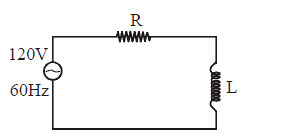In the given circuit diagram, potential difference across 2Ω resistance is

A
4V
B
6V
C
20V
D
zero
Video Solution
Text Solution
The correct Answer is:D
(d) Since it is a balanced Wheatstone bridge, potential difference across 2Ω resistance is zero.
|
Topper's Solved these Questions
- CURRENT ELECTRICITYBOOK - A2ZCHAPTER - CURRENT ELECTRICITYEXERCISE - R-C Circuits
17 Videos
- CURRENT ELECTRICITYBOOK - A2ZCHAPTER - CURRENT ELECTRICITYEXERCISE - Ammeter And Voltmeter
41 Videos
- CURRENT ELECTRICITYBOOK - A2ZCHAPTER - CURRENT ELECTRICITYEXERCISE - Combination And Resistivity
38 Videos
- ATOMIC PHYSICSBOOK - A2ZCHAPTER - ATOMIC PHYSICSEXERCISE - Section D - Chapter End Test
30 Videos
- DUAL NATURE OF RADIATION AND MATTERBOOK - A2ZCHAPTER - DUAL NATURE OF RADIATION AND MATTEREXERCISE - Section D - Chapter End Test
30 Videos
Similar Questions
Knowledge Check
In the given circuit the potential difference across resistance is 54 V and power consumed by it is 16 W. If AC frequency is 60Hz find the value of L:-
 A1 HB2 HC5 HD4H
A1 HB2 HC5 HD4HIn the above question, potential difference across the 40Ω resistance will be
AZeroB80VC40VD120VA voltmeter having resistance of 1800Ω is employed to measure the potential difference across 200Ω resistance which is connected to DC power supply of 50 V and internal resistance 20Ω. What is the percentage change in potential difference across 200Ω resistance as a result of connecting voltmeter across it ?
A0.01B0.05C0.1D0.2
In the circuit diagram shown in figure, potential difference across 3Ω resistance is 20 V. Then, match the following two columns.

View SolutionIn the given circuit find potential difference across 10ohm resistance

View SolutionIn the given circuit, if the potential difference across the internal resistance r1 is equal to E, then the resistance R is equal to:

View SolutionPotential difference between the points A and B in the circuit shown is 16 V, then potential difference across 2Ω resistor is …. Volt. (VA>VB)

View SolutionThe potential difference across 4Ω will be.
 .
.
View Solution


